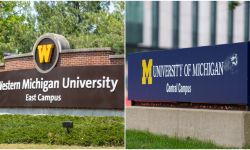Choice of Michigan college can make a (million-dollar) difference

Which Michigan campus you attend can make a million-dollar difference by the time you retire, according to a new study.
A Georgetown University analysis of federal data ranking 4,500 schools nationwide found startling differences in return on investment among campuses, and suggests some community colleges provide as much bang for the buck as some four-year universities, at least in the shorter term.
The study results represent a first stab at estimating the lifetime return on investment (ROI) for students at higher education institutions across the country, and has some severe limitations. Still, the analysis, based on federal College Scorecard data, sheds broad-stroke light on the financial payoff of college, and the earnings differential among various schools.
Among Michigan’s four-year colleges, tiny Kuyper College, based in Grand Rapids with an enrollment of 200, has about a third of the return on investment of Kettering University, an engineering powerhouse in Flint with close ties to the auto industry.
“Kettering University is a jewel in American higher education,” said Kettering President Robert McMahan. “We have been referred to as the West Point of industry, and our alumni are some of the most successful corporate leaders in the country.”
The University of Michigan and Michigan State are near the top in return on investment, as are the business-oriented private schools Lawrence Technological University in Southfield and Cleary University in Howell.
Michigan lags the majority of states in college attainment rates, with fewer than 30 percent of adults holding at least a bachelor’s degree. In Minnesota, for example, 35 percent of adults have a bachelor’s degree or higher.
- Related: Why rural Michigan teens are skipping out on college/ It’s not grades
- Related: Community college costs soar in Michigan. Blame sinking state aid.
One reason could be cost. Tuition at Michigan’s public universities is higher than in most states, possibly because state support of public universities has declined. Also, Michigan is notably stingy with college financial aid for aspiring students. Michigan college student debt has increased $10,000 in the past decade.
The result: Michigan families pay an average of 69 percent of the cost at public universities, the sixth-highest rate in the nation. Illinois families, by comparison, pay 32 percent of the cost at public universities.
That cost has an impact on enrollment. In rural Michigan, students enroll in college at a lower rate than in suburban parts of the state, in part because of fear of accruing debt without financial benefit.
The Georgetown study “absolutely destroys the case that college loans are a bad investment,” said Lou Glazer, president of the Ann Arbor-based think tank, Michigan Future and a strong proponent of students seeking a college degree. Those who enroll in college “have an enormous advantage” over those who don’t, Glazer said.
The Georgetown study did not examine the paycheck premium for a college degree over a high school diploma, but other studies have found that a person with a bachelor’s degree earns on average $1 million more over the course of their career than the average high school grad.
Among the findings in the study:
- Community colleges provide a bigger bang for the buck over the first 10 years after enrollment than four-year universities. That’s because community colleges cost less, and because students attending community college full-time typically join the workforce in two years, instead of after four years for university students. At 10 years after enrollment, 21 of the top 25 Michigan campuses for highest return on investment were community colleges.
- At 40 years after enrollment, though, the top 30 institutions for return on investment were all four-year schools, led by Kettering and Michigan Tech University in Houghton. The top community college for lifetime ROI was Schoolcraft College in Livonia.
- Kettering was tops in Michigan for 40-year ROI, and 32nd in the nation, above Princeton and Notre Dame. The top three in the country were pharmacy schools, followed by Massachusetts Institute of Technology and Stanford University.
Schoolcraft, with connections to auto suppliers, offers a bigger bang for the buck ($769,000) than some four-year campuses, including Northern Michigan University in Marquette ($738,000).
Schoolcraft has an enrollment of 17,000, and large programs in nursing, business, criminal justice engineering and culinary sciences. “We are very proud of the programs we have,” said Van Nguyen, executive director of marketing and communications for the school. “We are a hidden gem people don’t know about.”
Northern Michigan spokesman Derek Hall explained one reason for the school’s low ROI figure is that, despite being a four-year public university, one in five students at NMU earns a certificate or associate’s degree – programs the school offers to serve the isolated region of the state where the campus is located.
“We are just as proud of our top-notch truck driving certificate as we are our outstanding pre-med program,” said Fritz Erickson, NMU president. “If there is a need in our community or region, we will do it.”
The Georgetown study offers a handy comparison between colleges, but its 40-year earnings figures are conservative. For example, federal earnings data currently stops at 10 years after a student first enrolls at college, so the analysis assumes individuals continue to earn that salary for the next 30 years.
In addition, the data includes all students who enroll at a college and doesn’t distinguish between those who earn a degree (and thus likely earn more) and those who drop out. Thus, schools with higher dropout rates have lower average return on investment.
Also, the earnings figures are in today’s dollars, and do not assume inflation or raises.
In her first State of the State address in February, Gov. Gretchen Whitmer set a goal or having 60 percent of Michigan adults with a post-high school credential by 2030 (that figure is now 43 percent). She’s advocated efforts to increase enrollment in college and skilled trades training, and pushed to make community college or two years at public universities debt-free – a plan that has yet to gain traction in the Legislature.
Study authors were not available for comment. But Michigan Future’s Glazer said the key takeaway of the analysis for him is that despite rising student loan debt, college is still a good investment.
“Everyone who writes those stories (about rising college debt) went to college and send their kids to college,” Glazer said. “The reason why wages are higher for people with four-year degrees is because there is more demand than supply.”
Michigan Education Watch
Michigan Education Watch is made possible by generous financial support from:
Subscribe to Michigan Education Watch
See what new members are saying about why they donated to Bridge Michigan:
- “In order for this information to be accurate and unbiased it must be underwritten by its readers, not by special interests.” - Larry S.
- “Not many other media sources report on the topics Bridge does.” - Susan B.
- “Your journalism is outstanding and rare these days.” - Mark S.
If you want to ensure the future of nonpartisan, nonprofit Michigan journalism, please become a member today. You, too, will be asked why you donated and maybe we'll feature your quote next time!






